二丁基氧化锡
一般危化品
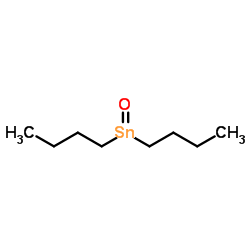
二丁基氧化锡结构式
|
常用名 | 二丁基氧化锡 | 英文名 | Dibutyltin oxide |
|---|---|---|---|---|
| CAS号 | 818-08-6 | 分子量 | 248.938 | |
| 密度 | 1,5 g/cm3 | 沸点 | >300°C | |
| 分子式 | C8H18OSn | 熔点 | ≥300 °C(lit.) | |
| MSDS | 中文版 美版 | 闪点 | 81-83°C | |
| 符号 |




GHS05, GHS06, GHS08, GHS09 |
信号词 | Danger |
二丁基氧化锡用途用途一: 用作制备二丁基锡类稳定剂的中间体,用于生产月桂酸二丁基锡、马来酸二丁基锡、马来酸单丁酯二丁基锡。 用途二:
是合成有机锡的中间体之一,应用于PVC热稳定剂、SPC自抛光海洋防污涂料等 更多
|
| 中文名 | 二正丁基氧化锡 |
|---|---|
| 英文名 | dibutyl(oxo)tin |
| 中文别名 | 二丁基氧化锡 | 二丁基氧化锡 | 二丁基氧化锡(剧毒) |
| 英文别名 | 更多 |
| 密度 | 1,5 g/cm3 |
|---|---|
| 沸点 | >300°C |
| 熔点 | ≥300 °C(lit.) |
| 分子式 | C8H18OSn |
| 分子量 | 248.938 |
| 闪点 | 81-83°C |
| 精确质量 | 250.037964 |
| PSA | 17.07000 |
| LogP | 3.00860 |
| 外观性状 | 白色粉末 |
| 储存条件 | 保持容器密封,储存在阴凉,干燥的地方。 |
| 稳定性 | 1.常温常压下稳定,避免氧化物接触。 2.具有C-Sn键而具有较高的毒性,建议在通风橱中操作和使用。 |
| 水溶解性 | 4.0 mg/L (20 ºC) |
| 计算化学 | 1.疏水参数计算参考值(XlogP):无 2.氢键供体数量:0 3.氢键受体数量:1 4.可旋转化学键数量:6 5.互变异构体数量:无 6.拓扑分子极性表面积17.1 7.重原子数量:10 8.表面电荷:0 9.复杂度:81.3 10.同位素原子数量:0 11.确定原子立构中心数量:0 12.不确定原子立构中心数量:0 13.确定化学键立构中心数量:0 14.不确定化学键立构中心数量:0 15.共价键单元数量:1 |
| 更多 | 1. 性状:白色到微黄色粉末 2. 密度:1.5 g/cm3 3. 相对蒸汽密度(g/mL,空气=1):未确定 4. 熔点(ºC):>300 5. 沸点(ºC,常压):未确定 6. 沸点(ºC,5.2kPa):未确定 7. 折射率:未确定 8. 闪点(ºC):81-83 9. 比旋光度(º):未确定 10. 自燃点或引燃温度(ºC):未确定 11. 蒸气压(kPa,25ºC):未确定 12. 饱和蒸气压(kPa,60ºC):未确定 13. 燃烧热(KJ/mol):未确定 14. 临界温度(ºC):未确定 15. 临界压力(KPa):未确定 16. 油水(辛醇/水)分配系数的对数值:未确定 17. 爆炸上限(%,V/V):未确定 18. 爆炸下限(%,V/V):未确定 19. 溶解性:溶于大多数有机溶剂,常常在苯、甲苯或者CH3OH溶液中使用。 |
|
|||||||||||||||||||||||||||||||||||||||||||||||||||||||||||||||||||||||||||||||||||||||||||||||||||||||||||||||||||||||||||||||||||||||||||||||||||||||||||||||||||||||||||||||||||||||||||||||||||||||||||||||||||||||||||||||||||||||||||||||||||||||
|
二丁基氧化锡毒理学数据: 急性毒性:大鼠口经LD50:44900ug/kg,大鼠腹腔LD50:40mg/kg 二丁基氧化锡生态学数据: 对水是稍微有害的,不要让未稀释或大量的产品接触地下水,水道或者污水系统,若无政府许可,勿将材料排入周围环境。 |
| 符号 |




GHS05, GHS06, GHS08, GHS09 |
|---|---|
| 信号词 | Danger |
| 危害声明 | H301-H315-H317-H318-H341-H360-H370-H372-H411 |
| 警示性声明 | P201-P260-P273-P280-P301 + P310-P305 + P351 + P338 |
| 靶器官 | thymus gland |
| 个人防护装备 | Eyeshields;Faceshields;Gloves;type P2 (EN 143) respirator cartridges |
| 危害码 (欧洲) | T:Toxic |
| 风险声明 (欧洲) | R25 |
| 安全声明 (欧洲) | S36/37/39-S45-S24/25 |
| 危险品运输编码 | UN 3146 6.1/PG 2 |
| WGK德国 | 3 |
| RTECS号 | WH7175000 |
| 包装等级 | II |
| 危险类别 | 6.1 |
| 海关编码 | 29310095 |
| 二丁基氧化锡上游产品 10 | |
|---|---|
| 二丁基氧化锡下游产品 10 | |
| 海关编码 | 29310095 |
|---|
|
Copolyesters made from 1,4-butanediol, sebacic acid, and D-glucose by melt and enzymatic polycondensation.
Biomacromolecules 16(3) , 868-79, (2015) Biotechnologically accessible 1,4-butanediol and vegetal oil-based diethyl sebacate were copolymerized with bicyclic acetalized D-glucose derivatives (Glux) by polycondensation both in the melt at hig... |
|
|
Hydrogen-bond-mediated self-assembly of 26-membered diaza tetraester crowns of 3,5-disubstituted 1H-pyrazole. Dimerization study in the solid state and in CDCl3 solution.
J. Org. Chem. 76(20) , 8223-31, (2011) By using an improved synthetic method reported earlier, the cyclic stannoxanes obtained from RN-diethanolamine (R = Me, Bu) and dibutyltin oxide have been reacted with 1H-pyrazole-3,5-dicarbonyl dichl... |
|
|
Dibutyltin oxide--phenyl isocyanate system for regioselective phenylcarbamoylation of the hydroxy-groups of ribonucleosides.
Nucleic Acids Symp. Ser. (8) , s7-8, (1980) For partial phenylcarbamoylation of the hydroxy-groups of ribonucleosides, dibutyltin oxide--phenyl isocyanate system was found to be surperior to the bis(tributyltin) oxide--phenyl isocyanate system ... |
| Dibutyloxostannane |
| Dibutyloxide of tin |
| EINECS 212-449-1 |
| Tin,dibutyloxo |
| Stannane,dibutyloxo |
| dibutyl tin oxide |
| Dibutyl(oxo)stannane |
| Dibutyloxotin |
| Dibutylstannane oxide |
| Dibutyltin(IV) oxide |
| Di-n-butyl-zinn-oxyd [German] |
| di-n-butyltin oxide |
| Stannane, dibutyloxo- |
| Dibutyltin Oxide GR |
| MFCD00001992 |
| Dibutyltin oxide |

 CAS号71-36-3
CAS号71-36-3 CAS号1002-53-5
CAS号1002-53-5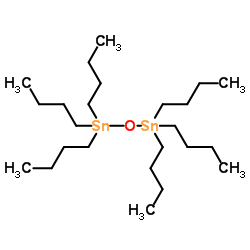 CAS号56-35-9
CAS号56-35-9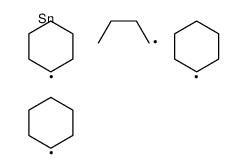 CAS号7067-44-9
CAS号7067-44-9 CAS号1118-46-3
CAS号1118-46-3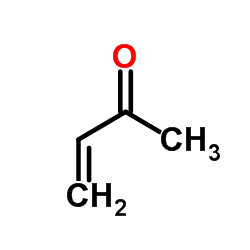 CAS号78-94-4
CAS号78-94-4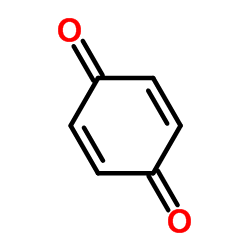 CAS号106-51-4
CAS号106-51-4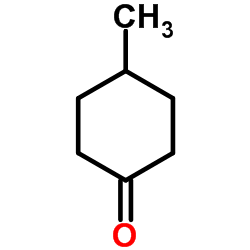 CAS号589-92-4
CAS号589-92-4 CAS号98-53-3
CAS号98-53-3 CAS号119-61-9
CAS号119-61-9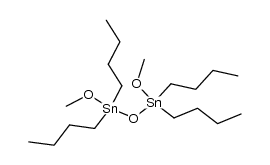 CAS号5926-85-2
CAS号5926-85-2 CAS号1067-55-6
CAS号1067-55-6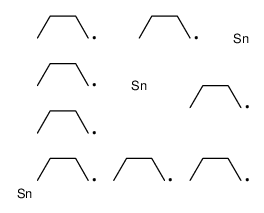 CAS号1066-68-8
CAS号1066-68-8![[dibutyl-[2-(2-chlorophenoxy)acetyl]oxystannyl] 2-(2-chlorophenoxy)acetate结构式](https://image.chemsrc.com/caspic/340/104697-81-6.png) CAS号104697-81-6
CAS号104697-81-6![butoxy-[butoxy(dibutyl)stannyl]oxy-dibutylstannane结构式](https://image.chemsrc.com/caspic/111/34833-46-0.png) CAS号34833-46-0
CAS号34833-46-0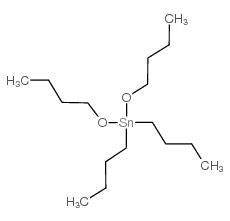 CAS号3349-36-8
CAS号3349-36-8 CAS号563-25-7
CAS号563-25-7 CAS号17997-43-2
CAS号17997-43-2 CAS号2050-95-5
CAS号2050-95-5![[(4-aminobenzoyl)oxy-dibutylstannyl] 4-aminobenzoate结构式](https://image.chemsrc.com/caspic/069/20556-88-1.png) CAS号20556-88-1
CAS号20556-88-1